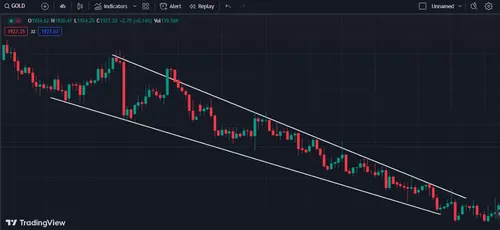Our partner, XM, lets you access a free demo account to apply your knowledge.
No hidden costs, no tricks.

Bear markets refer to the downward movement of the price of any asset on financial markets. When EURUSD moves downward, we say that EURUSD is facing a bear market. In Forex trading, 'Bulls' and 'Bears' are the most commonly used slang, referring to the upward and downward movement of the prices.
Let’s dive deeper into essential concepts of bear markets and how to take advantage of them.
Bear markets or downtrends are characterized by lower prices over extended periods. It is easier to see bear markets visually on the charts.

The chart of XAUUSD (Gold) in the picture above depicts a typical downtrend in the FX market. We can see the pattern of lower lows, where every new low point in price is lower than a previous low point. This concept of ‘lower lows’ is essential, and every trader must know. Lower lows are another concept widely used in the technical analysis of FX markets.
One way to detect bear markets is to draw the line connecting the two most recent lower lows and visually confirm the ongoing bear markets. These lines are called trend lines, and traders actively use them in technical analysis. Traders must also see 'lower highs' to confirm the ongoing bear markets.

It is quite rare for the market to start a downtrend immediately without several warning signs. Knowing these signs can help traders detect possible bear markets early. Detecting the bear market early can give traders an edge to make a profit and catch the major movement earlier. The longer the bear market continues, the more likely it will end or switch to consolidation.
The persistent price decline is the most obvious sign of bear markets. If you see the market making new highs that are lower than previous highs, with lower lows, then a bear market has been detected.
The second most obvious sign is negative macroeconomic news. Worse employment rates, slower GDP growth, and declining interest rates are great predictors of bear markets. If major economic indicators display worsening economic conditions, bear markets will follow. Awaiting bear markets and using technical indicators can considerably enhance accuracy. The 200-day moving average is among the most popular indicators. Both fundamental and technical traders use this long-period moving average to see if the price is bearish or bullish. When the value of an asset falls below the 200-day moving average, it indicates a possible bear market.
Another sign of a bear market is an inverted yield curve. When short-term interest rates rise above long-term rates, then there is a high likelihood of both economic downturns and bear markets occurring. Corporate earnings decreasing can also indicate the possibility of bear markets.
Bear markets are an essential part of Forex and other financial markets. Bear markets are defined by a consistent pattern of lower lows and lower highs, indicating sustained and prolonged price declines. The most common signs of bear markets are worsening economic conditions. Traders use fundamental and technical indicators such as the 200-day moving average, interest rates, employment rates, GDP, etc. Combining these indicators will increase the chances of detecting signs of upcoming bear markets.
Our partner, XM, lets you access a free demo account to apply your knowledge.
No hidden costs, no tricks.